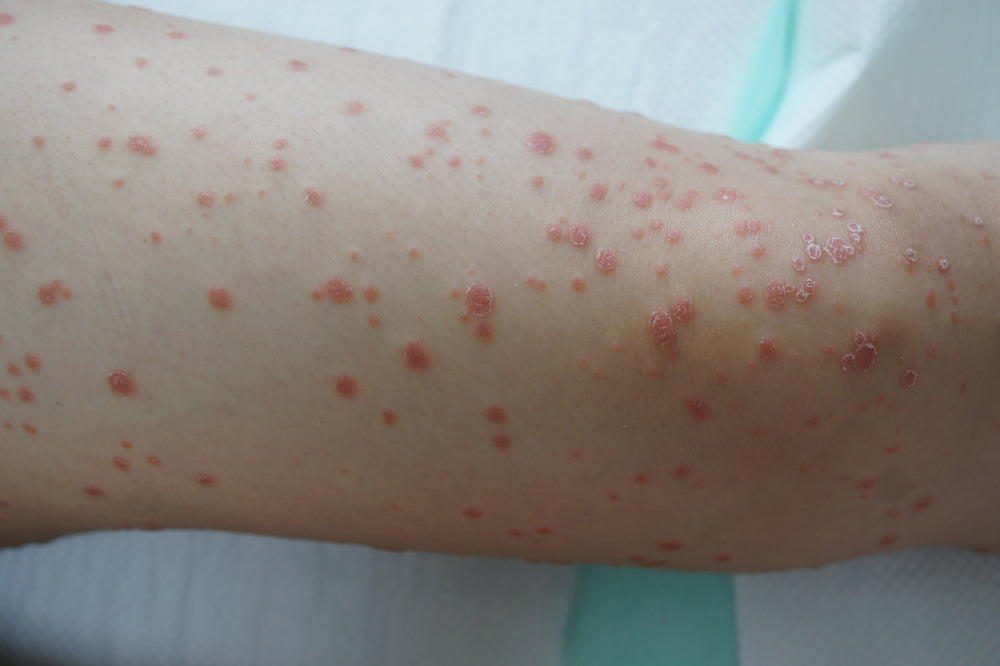What Does Guttate Psoriasis Look Like?
06 Feb 19

Psoriasis is the most common immune-mediated disease in the country, affecting about 2 to 3 percent of the U.S. population (roughly 8 million residents). However, it comes in several different types. Understanding what each type is can help with treatment and provide more peace of mind. Guttate psoriasis is just one form of psoriasis. Read on to learn what guttate psoriasis looks like so that you can better identify it.
What is Psoriasis?
Psoriasis is a skin condition that is characterized by a speed up in the skin cells’ natural lifecycle. This results in layers of skin cells growing on top of each other, which appears as dry, scaly patches of skin. These patches can be dry to point of cracking or bleeding. With plaque psoriasis, which is the most common form of the disease, these patches are thick and often itchy.
Guttate Psoriasis Symptoms
An estimated 10 percent of all people with psoriasis will develop guttate psoriasis, which makes it the second most common form of the disease next to plaque psoriasis. Guttate psoriasis is similar to other forms of psoriasis in that it also involves the formation of skin lesions. However, its appearance is unique from other types of psoriasis.
The main distinguishing feature of guttate lesions is that they appear as small, red dots. Guttate comes from the Latin word for “drops” or “droplets.” With guttate psoriasis, it refers to the water droplet look and shape of the lesions. These lesions tend to be much thinner than the plaques of plaque psoriasis, but they are also more plentiful. It’s common to have hundreds of guttate lesions. Guttate psoriasis typically covers the trunk, arms, and legs, though it can appear just about anywhere on the skin. Lesions may even cover the face, scalp, or ears.
Other symptoms of guttate psoriasis include:
- Dry skin that may crack and bleed
- Itching
- Burning, sore skin
- Brittle, ridged, or deformed nails
- Stiff, swollen joints (psoriatic arthritis)
Guttate psoriasis may also precede or even coincide with other forms of psoriasis, meaning you may have guttate lesions and plaque psoriasis lesions at the same time.
Symptoms of guttate psoriasis usually last two to three weeks on average. However, psoriasis is a chronic disorder that often operates in cycles. You may experience a flare up for a few weeks or months that then subsides or goes into remission until the next flare up.
Guttate Psoriasis and Similar Conditions
Guttate psoriasis is easy to mistake for other common conditions. Seborrheic dermatitis, or seborrhea, is a type of skin condition involving the oil-producing glands found in the face, scalp, chest, groin, and upper back. Seborrheic dermatitis often results in rashes and lesions in these areas. Lesions tend to be undefined in shape and pink with yellow-brown scales.
Eczema, also known as atopic dermatitis, is another skin condition noted by a rash and patches of dry skin. However, eczema tends to be limited to the back of the knees or the insides of the elbows.
Dandruff is easy to mistake for psoriasis on the scalp. Dandruff is a form of seborrhea relegated to the scalp. It produces fine, greasy scales all over the head. Guttate psoriasis rarely affects only the scalp.
Diagnosing Guttate Psoriasis
The only way to truly know if you have guttate psoriasis is to get a professional diagnosis from your doctor. There currently is no singular test that can determine if you have guttate psoriasis, but your doctor can accurately and conclusively diagnose you given your medical history and a physical examination.
For a more thorough diagnosis, your doctor may take a biopsy, which involves taking a small sample of the affected skin. They will then examine the sample under a microscope to eliminate possibilities. For example, psoriatic lesions tend to look thicker than eczema under a microscope.
Your doctor can also determine your psoriasis based on your family history. Reports suggest that about one-third of people with psoriasis also have a family member with the condition. Make sure you also notify your doctor of any upper respiratory infections, particularly strep throat. Strep throat and other bacterial infections are known to trigger or cause guttate psoriasis, especially in kids.
Once you and your doctor know for sure that it’s guttate psoriasis, you can begin treatment. While there’s no cure for psoriasis, treatment aims to effectively reduce symptoms and provide greater comfort. Knowing what to look for is the first step in the process. From there, you can begin the process of healing and taking control of your skin.
Sources:
- https://www.psoriasis.org/content/statistics
- https://www.mayoclinic.org/diseases-conditions/psoriasis/symptoms-causes/syc-20355840
- https://www.psoriasis.org/about-psoriasis/types/guttate
- https://www.psoriasis.org/about-psoriasis
- https://www.everydayhealth.com/psoriasis/living-with/psoriasis-or-something-else/
- https://www.webmd.com/skin-problems-and-treatments/psoriasis/guttate-psoriasis#1

